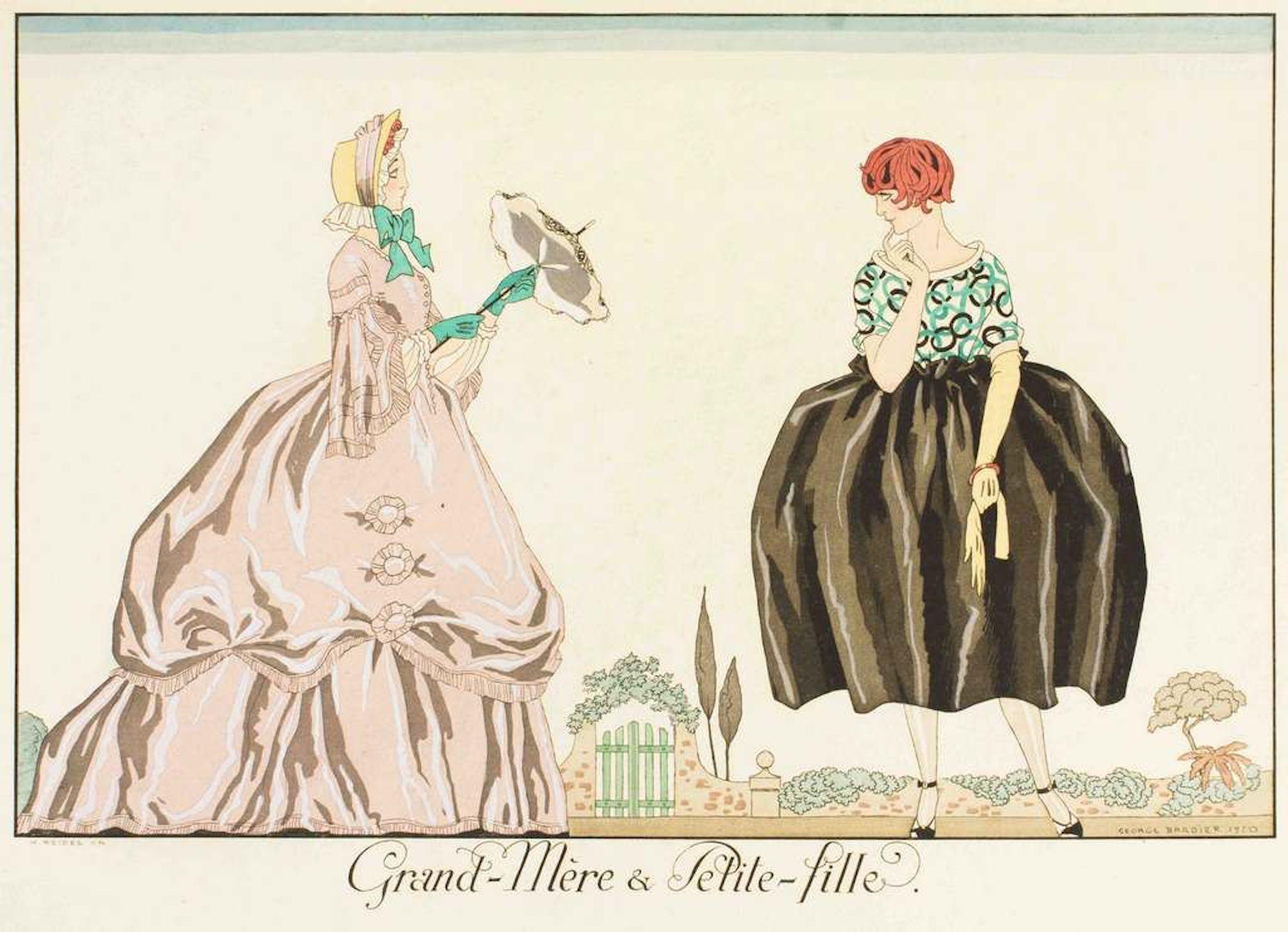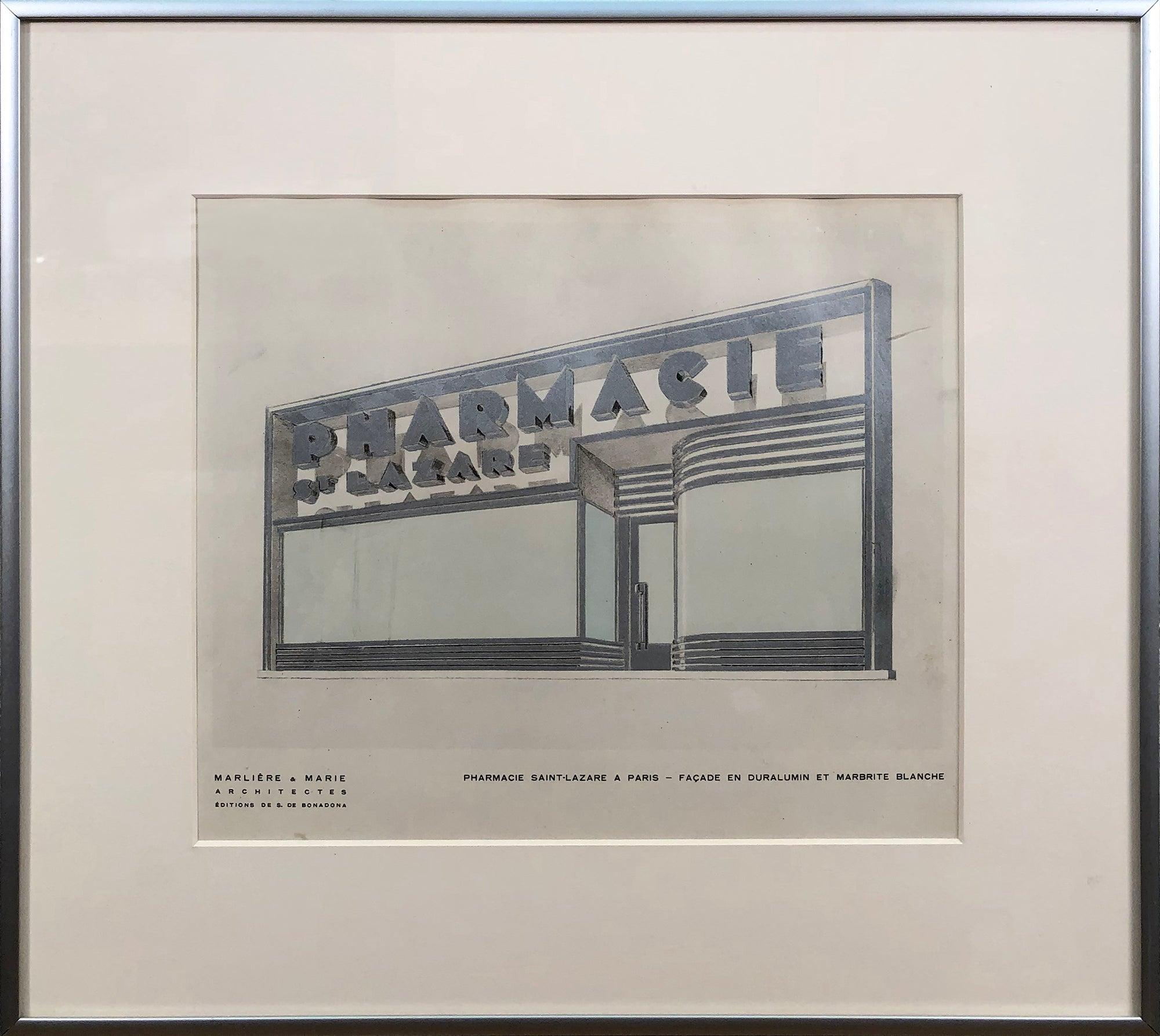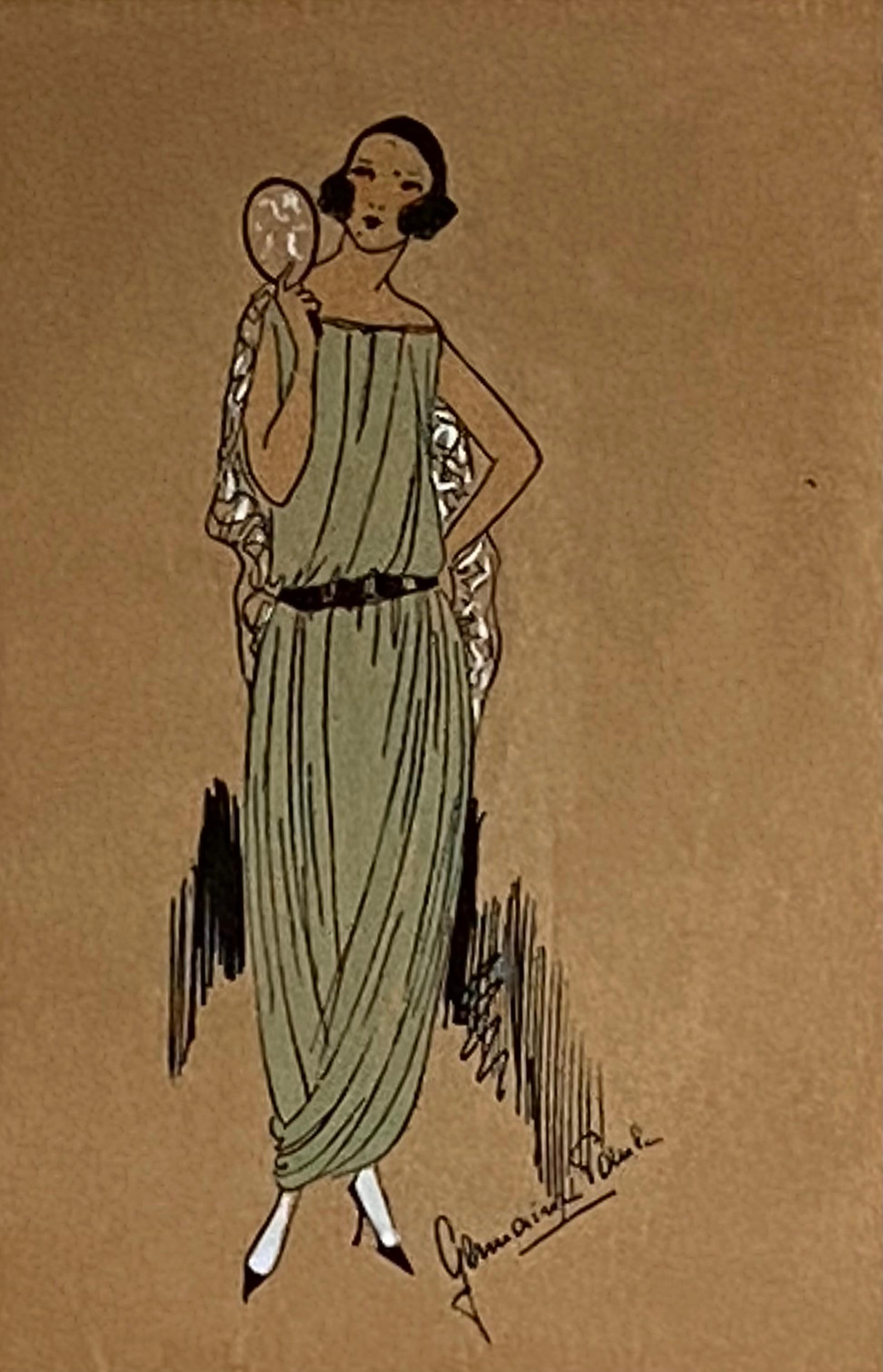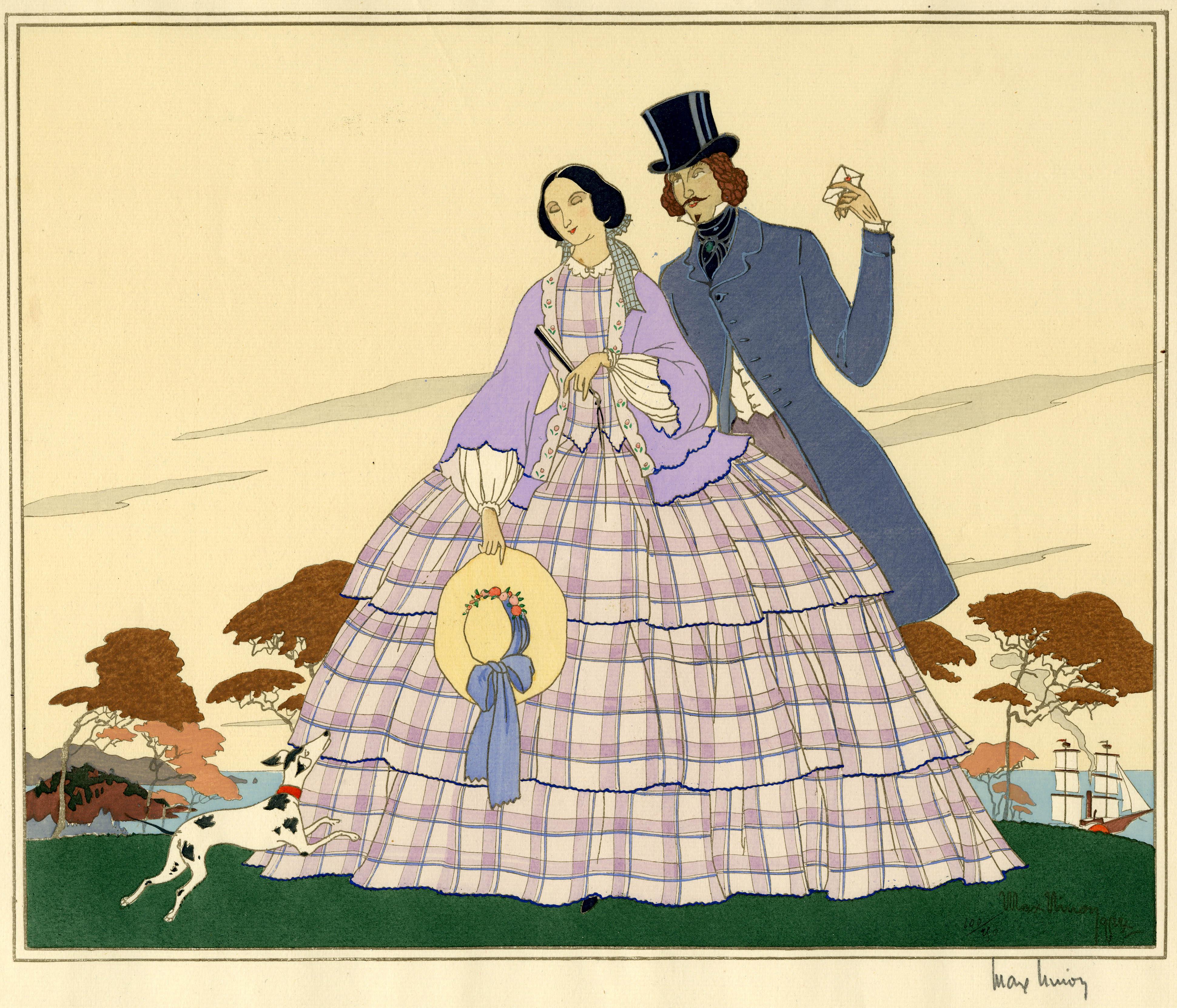Items Similar to Two Turkeys, Pochoir by Georges Manzana Pissarro
Want more images or videos?
Request additional images or videos from the seller
1 of 10
Georges Manzana PissarroTwo Turkeys, Pochoir by Georges Manzana Pissarrocirca 1920
circa 1920
About the Item
Two Turkeys by Georges Manzana Pissarro (1871 - 1961)
Pochoir with hand-coloured metallic paint
42 x 59.5 cm (16 ½ x 23 ⅜ inches)
Signed with Estate stamp, lower left
Numbered 1/25
Created circa 1920
Provenance
Private Collection, London
Artist biography
Like all second-generation Pissarro artists, Georges Henri ‘Manzana’ Pissarro initially worked under a pseudonym. Born in 1871, Manzana was the third of Camille Pissarro’s seven children, adopting the name ‘Manzana’ in 1894 after the maiden name of his maternal grandmother. It was not until around 1910, to honour his deceased father, that he employed his family name when signing his work.
Manzana studied with his father from an early age and spent his formative years surrounded by the distinguished artists associated with the Impressionist movement – Claude Monet, Paul Cézanne, and Paul Gauguin – who frequented the Pissarro home in Éragny. At his father's side he learnt not only to handle brush and pencil but also to observe nature and its changing qualities.
Subjected to rich and diverse influences, Manzana became a prolific and versatile artist, working with oil, pastel and watercolour as well as etchings, lithography and stencils. As a young man he adopted his father's purely Impressionist style and produced a series of landscapes around Éragny. He exhibited Impressionist works at the Salon d'Automne and the Salon des Indépendants, as well as Durand Ruel and Druet galleries in Paris in the early 1900s.
In 1906 his work began to evolve. Inspired by Dr Mardus’ French translation of ‘A Thousand and One Nights’, Manzana embarked on a grand project to publish his own illustrated version of these magical tales. This pulled Manzana into the umbrella of the decorative arts movement where he flourished creating tapestries, glassware, furniture, ceramics and metal work, all inspired by Orientalism and often incorporating gold, silver and copper paint. In 1907 he had his first exhibition of decorative works at Vollard but it was the 1914 exhibition at the Musée des Arts Décoratifs in Paris which dramatically boosted his career. Here he exhibited 311 works including tapestries, carpets, furniture, glassware, decorative paintings, etchings and lithographs.
The subsequent years were filled with bright ideas, gilded costumes and a glittering lifestyle as Manzana navigated the 20s and 30s between Les Andelys and Paris, spending many summers in Brittany. These culminated in a series of colourful yet delicate new works which Manzana exhibited prolifically. When war broke out in 1939 Manzana moved with his family to Casablanca, where he remained until 1947. Manzana was married and widowed three times. The last years of his life were spent in Menton with his son Félix who was also an accomplished artist. There Manzana returned to the Impressionist tradition of his early years, painting the serene landscapes that surrounded him.
- Creator:Georges Manzana Pissarro (1871 - 1961, French)
- Creation Year:circa 1920
- Dimensions:Height: 16.54 in (42 cm)Width: 23.43 in (59.5 cm)
- Medium:
- Movement & Style:
- Period:
- Condition:
- Gallery Location:London, GB
- Reference Number:1stDibs: LU26128516322
Georges Manzana Pissarro
Like all second-generation Pissarro artists, Georges Henri ‘Manzana’ Pissarro initially worked under a pseudonym. Born in 1871, Manzana was the third of Camille Pissarro’s seven children, adopting the name ‘Manzana’ in 1894 after the maiden name of his maternal grandmother. It was not until around 1910, to honour his deceased father, that he employed his family name when signing his work. Manzana studied with his father from an early age and spent his formative years surrounded by the distinguished artists associated with the Impressionist movement – Claude Monet, Paul Cézanne, and Paul Gauguin – who frequented the Pissarro home in Éragny. At his father's side he learnt not only to handle brush and pencil but also to observe nature and its changing qualities. Subjected to rich and diverse influences, Manzana became a prolific and versatile artist, working with oil, pastel and watercolour as well as etchings, lithography and stencils. As a young man he adopted his father's purely Impressionist style and produced a series of landscapes around Éragny. He exhibited Impressionist works at the Salon d'Automne and the Salon des Indépendants, as well as Durand Ruel and Druet galleries in Paris in the early 1900s. In 1906 his work began to evolve. Inspired by Dr Mardus’ French translation of ‘A Thousand and One Nights’, Manzana embarked on a grand project to publish his own illustrated version of these magical tales. This pulled Manzana into the umbrella of the decorative arts movement where he flourished creating tapestries, glassware, furniture, ceramics and metal work, all inspired by Orientalism and often incorporating gold, silver and copper paint. In 1907 he had his first exhibition of decorative works at Vollard but it was the 1914 exhibition at the Musée des Arts Décoratifs in Paris which dramatically boosted his career. Here he exhibited 311 works including tapestries, carpets, furniture, glassware, decorative paintings, etchings and lithographs. The subsequent years were filled with bright ideas, gilded costumes and a glittering lifestyle as Manzana navigated the 20s and 30s between Les Andelys and Paris, spending many summers in Brittany. These culminated in a series of colourful yet delicate new works which Manzana exhibited prolifically. When war broke out in 1939 Manzana moved with his family to Casablanca, where he remained until 1947. Manzana was married and widowed three times. The last years of his life were spent in Menton with his son Félix who was also an accomplished artist. There Manzana returned to the Impressionist tradition of his early years, painting the serene landscapes that surrounded him.
About the Seller
5.0
Recognized Seller
These prestigious sellers are industry leaders and represent the highest echelon for item quality and design.
Gold Seller
These expertly vetted sellers are highly rated and consistently exceed customer expectations.
Established in 1964
1stDibs seller since 2015
95 sales on 1stDibs
Typical response time: 8 hours
Associations
Society Of London Art Dealers
- ShippingRetrieving quote...Ships From: London, United Kingdom
- Return PolicyA return for this item may be initiated within 7 days of delivery.
More From This SellerView All
- The Green Woodpecker by Georges Manzana Pissarro - Animal stencilBy Georges Henri Manzana PissarroLocated in London, GB*UK BUYERS WILL PAY AN ADDITIONAL 20% VAT ON TOP OF THE ABOVE PRICE The Green Woodpecker by Georges Manzana Pissarro (1871-1961) Pochoir 31 x 47 cm (12 ¹/₄ x 18 ¹/₂ inches) Signed w...Category
1920s Post-Impressionist Animal Prints
MaterialsStencil
- Three Hens by Georges Manzana Pissarro - Animal stencilBy Georges Henri Manzana PissarroLocated in London, GBThree Hens by Georges Manzana Pissarro (1871-1961) Pochoir 31.8 x 48.3 cm (12 ½ x 19 inches) Signed with Estate stamp and épreuve d'état Provenance Private Collection, London Artis...Category
19th Century Post-Impressionist Animal Prints
MaterialsStencil
- Les poules by Georges Manzana Pissarro - StencilBy Georges Henri Manzana PissarroLocated in London, GBLes poules by Georges Manzana Pissarro (1871-19610 Pochoir 30 x 46 cm (11 ³/₄ x 18 ¹/₈ inches) Signed with Estate stamp Manzana Pissarro and numbered 7/100 lower left Artist biograp...Category
20th Century Animal Prints
MaterialsStencil
- Peacocks by Georges Manzana Pissarro - Animal pochoirBy Georges Henri Manzana PissarroLocated in London, GBPeacocks by Georges Manzana Pissarro (1871-1961) Pochoir 31.3 x 49.5 cm (12 ³/₈ x 19 ¹/₂ inches) Signed with Estate stamp Manzana Pissarro and numbered 45/100 lower right Provenance...Category
1920s Animal Prints
MaterialsStencil
- Les cygnes by Georges Manzana Pissarro - Animal themed monotypeBy Georges Henri Manzana PissarroLocated in London, GB*UK BUYERS WILL PAY AN ADDITIONAL 20% VAT ON TOP OF THE ABOVE PRICE Les cygnes by Georges Manzana Pissarro (1871-1961) Watercolour monotype 49 x 63 cm (19 ¹/₄ x 24 ³/₄ inches) Signe...Category
1920s Art Deco Animal Prints
MaterialsWatercolor, Monotype
- The Japanese Girl by Orovida Pissarro - Watercolour on paperBy Orovida PissarroLocated in London, GBThe Japanese Girl by Orovida Pissarro (1893-1968) Watercolour on paper 17.78 x 12.7 cm (7 x 5 inches) Signed lower right, Orovida Circa 1920 This highly original piece has the origi...Category
1920s Art Deco Portrait Drawings and Watercolors
MaterialsWatercolor, Paper
You May Also Like
- Grand-mere et Petite-fille - Pochoir by G. Barbier - 1920By George BarbierLocated in Roma, ITThis pochoir belongs to the portfolio 'Le Bonheur du Jour', by George Barbier. A very fine work of one of the most important and famous european illustrators of Art Deco, whose infl...Category
1920s Art Deco Figurative Prints
MaterialsStencil
- L'apres-midi d'un Faune - Pochoir by G. Barbier - 1920By George BarbierLocated in Roma, ITThis is one of the artworks in the portfolio 'Le Bonheur du Jour', by George Barbier. A very fine work of one of the most important and famous european illustrators of Art Deco, who...Category
1920s Art Deco Figurative Prints
MaterialsStencil
- Henry Delacroix 'Pharmacie Saint-Lazare a Paris' 1930- PochoirBy Henry DelacroixLocated in Brooklyn, NYPaper Size: 14 x 15.5 inches ( 35.56 x 39.37 cm ) Image Size: 8.75 x 10.25 inches ( 22.225 x 26.035 cm ) Framed: Yes Frame Size: Condition: A-: Near Mint, very light signs of handli...Category
1930s Art Deco Prints and Multiples
MaterialsStencil
- “Sylvia”Located in Southampton, NYOriginal fashion illustration for Tres Parisien, December, 1921 Moroccan Crepe Dress by Germaine-Paule Joumard, Fashion Art Deco Pochoir on Chinese Paper. Artwork size is 7.5 by 5 i...Category
1920s Art Deco Figurative Prints
MaterialsArchival Paper, Stencil
- Frontispiece for Le Bonheur du Jour - Pochoir by G. Barbier - 1929By George BarbierLocated in Roma, ITLe Bonheur du Jour by George Barbie (Nantes, 1889 - Paris, 1932) is an artwork realized in 1929. Original colored pochoir on cardboard. Perfect conditions. Le Bonheur du Jour is...Category
1920s Art Deco Figurative Prints
MaterialsStencil
- CoquetteBy Victor Max NinonLocated in Fairlawn, OHCoquette Pochoir (silk screen) printed in colors, c. 1923-1925 Signed by the artist in pencil lower right; numbered in ink on the image, (see photo) Edition: 250 (100/250) in pencil in image (see photo) Image size: 10-1/2 x 12-3/4" The artist won a gold medal in Paris in 1925 for his porchoirs Victor Max Ninon (Vittorio Accornero de Testa, Italian, 1896-1982) Biography Vittorio Accornero de Testa was born in Casale Monferrato in 1896. He completed his first studies at the "Leardi" institute, but was forced to interrupt them due to the war events of the First World War . At 19 he was second lieutenant of the Alpine troops and in 1916 he took one of the first pilot's licenses. During the war he knows the bitterness of shooting down in air combat (for which he is decorated), but also the good fortune to stay alive, albeit with a disability. His art blossomed in the postwar period, first signing his works simply Ninon and then, probably at the suggestion of a French publisher, under the pseudonym of "Victor Max Ninon" (Victor and Max indicate strength and masculinity, Ninon boyhood) .In 1919 and 1924 he made illustrations for theGiornalino della Domenica , also together with his first wife Edina Altara , for Ardita and La Lettura . In 1923 he won the cover competition organized by the magazine El Hogar of Buenos Aires and in 1925 with his pochoirs he imposed himself in Paris at the international exhibition of modern decorative and industrial arts , obtaining a gold medal. In the same year he made two covers for the US magazine The Smart Set . In the 1920s he made numerous series of art deco style postcards for the Milanese publishing house Degami . On June 4, 1929, aGenoa embarks on the Conte Grande together with his wife Edina Altara , for New York . The two stayed in the American metropolis for a few months: in this period Accornero worked on the creation of theatrical sets and created some covers for Country Life magazine . Accornero gets awards and prizes, but the great economic crisis of the time and the nostalgia for Italy convince the two to return to their homeland, where they resume their activity as illustrators. In 1934 Accornero moved to Milan, separated amicably from his wife and continued to dedicate himself to the illustration of children's books, abandoning the pseudonym Victor Max Ninon. It illustrates about 60 books, from the fables of Andersen , Perrault and Grimm , to the tales of Poe , as well as the famous Pinocchio and Cuore published by Mondadori, Mursia, Hoepli, Martello. Several books illustrated by Accornero have been published in French, Spanish, German and English. In addition to the periodicals already mentioned, he collaborates on the first edition of the Encyclopedia of Boys , Mondadori, and with the Italian magazines Lidel , Il Secolo XX, The Italian Illustration , Fantasies of Italy , The Woman , Cordelia , For You Lady , Grace , Metropolis , La Domenica del Corriere , The Corriere dei Piccoli . In 1936 enters the world of cinema, creating sets and costumes for Wedding Vagabonde of Guido Brignone and The White Squadron of Augustus Genina . From 1935 to 1950 he also devoted himself to the theater, taking care of sets and costumes for numerous operettas, ballets and performances at the Scala in Milan and for the Milanese theaters Manzoni, Lirico and Olympia. Stages Marcello di Giordano, Nina pazza d'amore by Paisiello, I cantori di Nurimberga by Wagner, La Bohème by Puccini and other works. For this activity he is also cited in the Theater encyclopedia. In the 1940s and 1950s he wrote and illustrated six books for children for Mondadori: Tomaso (1944), Giacomino (1949), Tomaso Cacciatore (1950), Zio Stefano (1950), In Campagna che delizia! (1953), Tomaso, dear Tomaso (1955). His illustrations of Perrault's Tales published in those years by Hoepli are famous. His art in the fifties evolves towards hyperrealism . There are many personal exhibitions in Italy and abroad, including those at the Gallerie Gussoni (1959) and Bolzani (1963 and 1966) in Milan and Walcheturm (1962) in Zurich. Eminent critics praise his work, from Orio Vergani to Enrico Piceni, from Reto Roedel to De Chirico himself. On the Domenica del Corriere , the journalist, writer and painter Dino Buzzati...Category
1920s Art Deco Figurative Prints
MaterialsStencil
Recently Viewed
View AllMore Ways To Browse
Antique Stenciled Furniture
Antique Furniture Stencils
Antique Oriental Prints
Monet Signed Prints
Pissarro Etching
Prints Claude Monet
Art Deco Sign Print Painting
Camille Pissarro Etching
Antique Side Turkey
Art Deco Oriental Antique
Antique Turkish Tapestry
Umbrella Prints
Pochoir Antique
Paul Durand
French Pochoirs
Turkish Costumes
Antique Metallic Paint
Antique Brown Glassware






